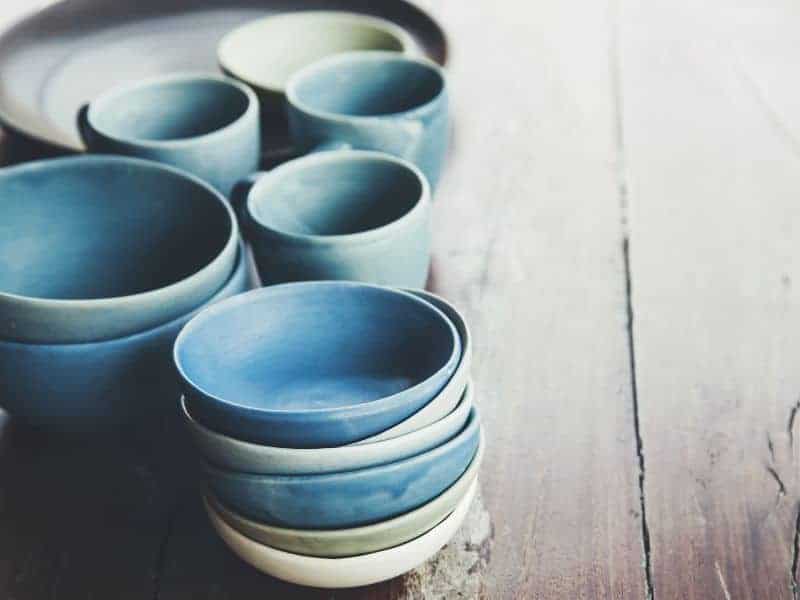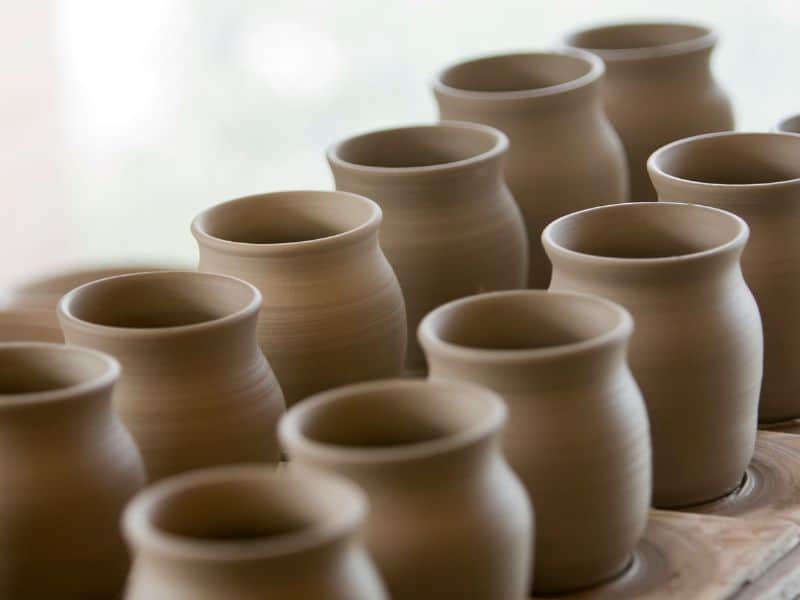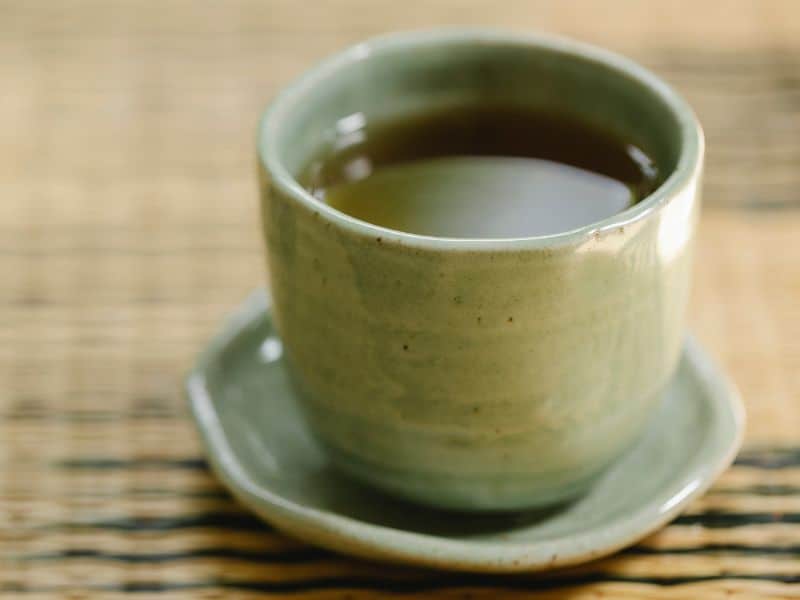Pottery is used for practical and decorative purposes. People who enjoy handmade pottery often wonder if it’s okay to put it in the dishwasher. However, it’s not a simple yes or no answer. To understand, we need to know about the characteristics of handmade pottery, how high temperatures can affect it, and the properties of ceramic glazes.
You can put handmade pottery in the dishwasher, provided it’s made from a thick durable clay, properly fired at high temperatures, and glazed correctly. However, frequent dishwashing may wear the glaze over time, and sudden temperature changes can potentially damaging the pottery.
While it’s convenient to clean handmade pottery in the dishwasher, it’s essential to consider its long-term care. If you want to preserve the beauty and integrity of your pottery pieces, consider alternating between hand washing and dishwashing.
Always ensure pottery is at room temperature before placing it in the dishwasher to avoid thermal shock. Remember, proper care can extend the lifespan of your cherished handmade pottery. Let’s take a closer look below.
Understanding Handmade Pottery
The type of clay used, such as stoneware clay or porcelain clay, can significantly influence the final product’s durability and aesthetic.
For instance, stoneware clay is known for its strength and durability, making it a popular choice for functional pieces like mugs and bowls. On the other hand, porcelain clay, known for its fine texture and translucency, is often used for more delicate and decorative pieces.
To illustrate the process of making pottery pieces, let’s consider the creation of a handmade mug. The potter starts by kneading the clay to remove any air bubbles. The clay is then shaped on a potter’s wheel, a process that requires both skill and patience. Once the desired shape is achieved, the mug is left to dry to a leather-hard state before the handle is attached.
After further drying, the mug is fired in a kiln at high temperatures, transforming the clay into a hard, durable material.
The Role of High Temperatures in Pottery Making
High temperatures play a crucial role in pottery making. The firing process, which involves heating the pottery in a kiln at high temperatures, is what transforms the soft, malleable clay into a hard, durable material. The right temperature for firing depends on the type of clay used. For example, stoneware clay is typically fired at higher temperatures than porcelain clay.
On the other hand, firing at lower temperatures may not fully vitrify the clay, leaving it porous and more susceptible to water absorption. This is particularly important when considering whether handmade pottery is dishwasher safe, as the high temperatures and hot water in a dishwasher could potentially damage under-fired pottery.
To understand how temperature changes affect a pottery piece during creation, consider a pottery piece made from stoneware clay. If the piece is fired at the correct temperature, the clay vitrifies, becoming non-porous and water-resistant. However, if the piece is fired at a lower temperature, the clay may not fully vitrify, leaving it porous and susceptible to water damage.
Are Ceramic Glazes Necessary?
Ceramic glazes serve both aesthetic and functional purposes in pottery. They can add color, texture, and pattern to a piece, enhancing its visual appeal. More importantly, glazes form a protective layer on the pottery, making it waterproof and more durable.
Glazes are composed of various minerals that melt and fuse to the pottery surface when exposed to high temperatures in the kiln. The resulting glass-like coating seals the pottery, making it resistant to water and stains. This is particularly important for pottery pieces that will be used for food or drink, such as handmade mugs.
However, not all pottery is glazed. Unglazed pottery, also known as bisqueware, has a porous surface and a matte appearance. While it can be beautiful in its own right, it’s more susceptible to staining and water damage compared to glazed pottery.
To illustrate the transformation of a pottery piece when glazed, imagine a simple, unglazed pottery mug. Once a glaze is applied and the mug is fired in the kiln, the glaze melts and fuses to the surface of the mug, giving it a glossy, glass-like finish. The once porous surface of the mug is now sealed, making it waterproof and more durable.
Handmade Mugs and Dishwashers: A Good Match?
The concept of dishwasher safe pottery is a topic of much debate among potters and pottery enthusiasts. On one hand, the high temperatures and hot water in a dishwasher can provide a thorough cleaning that’s hard to achieve by hand. On the other hand, these conditions could potentially damage certain types of pottery.
Factors that make handmade mugs dishwasher safe include the type of clay used, the maturity of the clay at the time of firing, and the type and maturity of the glaze. For instance, mugs made from stoneware clay and fired at high temperatures are generally more durable and can often withstand the rigors of a dishwasher.
However, there’s always a risk of thermal shock with hot water. Thermal shock occurs when a material is subjected to a sudden change in temperature. In the case of pottery, this could cause cracking or crazing (fine cracks in the glaze).
To illustrate this, let’s consider a handmade mug made from stoneware clay and glazed with a durable, high-temperature glaze. If the mug is properly fired and cooled, it should be able to withstand the heat and water pressure of a dishwasher. However, if the mug is taken from a cold environment and placed directly into a hot dishwasher, it could experience thermal shock, leading to potential damage.
Can Handmade Pottery Withstand the Dishwasher?
The high temperatures in a dishwasher can be a challenge for pottery. While many pottery pieces are fired at much higher temperatures than those found in a dishwasher, repeated exposure to the dishwasher’s heat and hot water can potentially cause damage over time.
Different types of clay respond differently to dishwasher use. Stoneware clay, for example, is known for its durability and can often withstand the dishwasher. Porcelain clay, while also durable, is more delicate and might not fare as well.
The importance of room temperature before and after dishwasher use should not be overlooked. A sudden change from a cold environment to the hot environment of a dishwasher can cause thermal shock, leading to cracks in the pottery.
To illustrate this, let’s observe the effects of a dishwasher cycle on different types of clay. A stoneware mug and a porcelain mug are both placed in the dishwasher. After the cycle, the stoneware mug comes out unscathed, while the porcelain mug shows signs of crazing. This demonstrates how the type of clay can influence a pottery piece’s dishwasher safety.
The Impact of Dishwasher Detergents on Handmade Pottery
Dishwasher detergents, while effective at cleaning, can have an impact on pottery pieces. These detergents are designed to be tough on food residues and can be equally tough on pottery, particularly on the glazes.
The interaction between detergents and ceramic glazes can lead to dulling of the glaze over time. Some detergents may also cause discoloration, particularly on lighter glazes.
Choosing the right dishwasher detergent for handmade pottery can help mitigate these effects. Opt for a gentle, pottery-friendly detergent, and avoid ones with harsh chemicals.
To illustrate this, let’s compare the effects of different dishwasher detergents on pottery. After several dishwasher cycles with a harsh detergent, a pottery mug shows signs of glaze dulling. In contrast, a mug washed with a gentle detergent retains its glossy glaze.
The Role of Dishwasher Settings in Preserving Handmade Pottery
Understanding different dishwasher settings can be crucial in preserving the integrity of your handmade pottery. Dishwashers typically have various settings that adjust the water temperature and pressure, and the duration of the wash cycle.
The best dishwasher settings for handmade pottery are usually those that provide a gentle wash at a lower temperature. This reduces the risk of thermal shock and minimizes wear on the pottery and its glaze.
Rinse aid, a common feature in many dishwashers, can also have an effect on handmade pottery. While it’s designed to improve drying and prevent water spots, it can potentially cause dulling of the glaze over time.
To illustrate this, let’s experiment with different dishwasher settings on pottery pieces. A pottery mug washed on a high-temperature, high-pressure setting shows signs of glaze wear after several washes. In contrast, a mug washed on a gentle, lower-temperature setting retains its glaze and appearance even after multiple washes.
Tips for Dishwashing Handmade Pottery
While many pieces of handmade pottery can be washed in the dishwasher, it’s essential to check if your specific piece is dishwasher safe. This information is often provided by the potter or retailer. If in doubt, it’s best to err on the side of caution and hand wash your pottery.
When washing pottery in the dishwasher, there are several precautions to take. Avoid placing pottery pieces too close together, as they can knock against each other during the wash cycle, causing chips or cracks. Also, remember to let your pottery return to room temperature before placing it in a hot dishwasher to avoid thermal shock.
If your pottery is not dishwasher safe, or if you want to extend its lifespan, consider alternatives to using a dishwasher. Hand washing with warm water and a gentle dish soap can be a safe and effective way to clean your pottery.
To illustrate this, let’s follow a step-by-step guide to safely washing a pottery piece in the dishwasher. First, ensure the piece is dishwasher safe. Next, place it in the dishwasher, ensuring it’s not touching any other items. Select a gentle, lower-temperature wash cycle, and use a pottery-friendly detergent. Once the cycle is complete, allow the pottery to cool inside the dishwasher before removing it.
Common Misconceptions about Dishwashing Handmade Pottery
When it comes to dishwashing handmade pottery, there are several misconceptions that can lead to unnecessary worry or, worse, damaged pottery. Understanding the facts can help you care for your pottery properly and enjoy it for many years to come.
One common myth is that all pottery is dishwasher safe. As we’ve discussed, the dishwasher safety of pottery depends on several factors, including the type of clay, the maturity of the clay and glaze, and the temperature changes the pottery is subjected to. Not all pottery meets the criteria for being dishwasher safe.
Another misconception is that dishwasher detergents are too harsh for pottery. While some detergents can cause dulling or discoloration of the glaze over time, others are perfectly safe for pottery. The key is to choose a gentle, pottery-friendly detergent.
To debunk a common myth about dishwashing pottery, let’s consider the belief that all glazed pottery is dishwasher safe. While glaze does provide a protective layer, not all glazes are created equal. Some glazes, particularly those fired at lower temperatures, may not withstand the rigors of a dishwasher. Therefore, it’s essential to check the dishwasher safety of each individual piece of pottery.
Frequently Asked Questions
To ensure your handmade pottery remains dishwasher safe, check with the potter or retailer for specific care instructions and avoid sudden temperature changes or extreme dishwasher settings.
Unglazed pottery is porous and can absorb water, making it more susceptible to damage in the dishwasher. It’s generally recommended to avoid dishwashing unglazed pottery.
To prevent thermal shock, allow your pottery to reach room temperature before placing it in a hot dishwasher. Gradual temperature changes help minimize the risk of cracking or damage.
If you’re unsure about the dishwasher safety of your handmade pottery or prefer to take extra precautions, hand washing with warm water and gentle dish soap is a safe alternative.
Some dishwasher detergents can cause glaze dulling or discoloration over time. Choosing a gentle, pottery-friendly detergent can help minimize these effects.
Conclusion
Understanding the intricacies of handmade pottery and its interaction with high temperatures, hot water, and dishwasher detergents can help you make informed decisions about how to care for your pottery. While many pieces of handmade pottery can withstand the dishwasher, it’s essential to consider factors like the type of clay, the maturity of the clay and glaze, and the potential for thermal shock.
In conclusion, the answer to the question, “Can I put handmade pottery in the dishwasher?” is, “It depends.” By understanding the factors at play and taking appropriate precautions, you can enjoy the beauty and functionality of your handmade pottery for many years to come.





